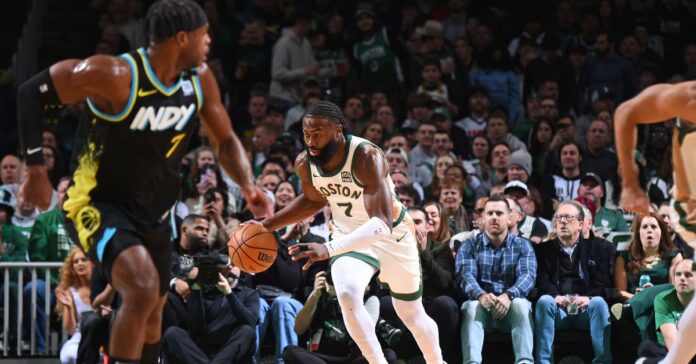People just can’t help themselves but to look past the entire Eastern Conference and assume that the Celtics will be playing for a title in a couple of weeks. But please, slow down, folks.
The Indiana Pacers will be a challenge; they’re an exciting and talented young basketball team with a plethora of ways to beat you, and Boston certainly shouldn’t be counting their chickens before they’re fully hatched.
Here are three ways for the Celtics to ensure that they handle their business.
1. Keeping Indiana out of transition
It’s a secret to absolutely nobody that the Indiana Pacers love to run in transition. It’s their identity. During the playoffs, Indiana ranks second in transition frequency and first in points per possession on transition possessions. In other words, they like to run a lot, and they’re quite good at it.
Miss or make, a Pacers player is grabbing the ball out of the basket and outletting it ahead to Tyrese Haliburton or T.J. McConnell as quickly as possible. The rest of the players – now under the correct assumption that their sprinting down the court will be rewarded with points – are making a consistent effort to bust their behinds to the front of the basket or the corner three-point line.
That’s what the Pacers do for the entire 48 minutes of the game, and that’s why it’s especially important for the Celtics, after both makes and misses, to sprint back on defense and get out to shooters as quickly as possible. Tatum, I’m looking at you. No more aggressively fouling in the backcourt or jogging back after missed layups. You may have gotten away with it against the Heat and the Cavs, but that’s what Indiana feeds on. Jayson and the rest of the team have to be as disciplined as they’ve been all playoffs.
Perfect example here of how a simple lapse after even a made bucket can result in a wide open three for Andrew Nembhard. I’m telling you, Celtics fans: Tyrese and T.J. are too smart and too fastbreak-oriented to not take advantage of these opportunities. You must sprint back, and you must do it for all 48 minutes. It’s just discipline and effort. That’s it.
The Celtics were the best transition defense in the NBA during the regular season but have been well below average in the playoffs. They’ll have to return to what they did all season in order to halt Indiana’s offense.
2. Offensive rebounding and winning the energy battle
If there’s one thing we learned from the Knicks/Pacers series, it’s that Indiana is vulnerable on the defensive glass. Okay, fine. Everybody is vulnerable on the defensive glass against the Knicks. But still, the Pacers have the 3rd worst defensive rebounding percentage throughout these playoffs and are not the toughest team when it comes to banging around inside.
Conversely, the Celtics are an entirely different team when Jrue Holiday and Al Horford are engaged on the boards. It’s one of the main ways that Boston is able to flex their physicality, and It’ll be especially relevant in a series against a team like Indiana.
Of course, offensive rebounding and transition defense don’t exactly go together like wine and cheese. If a team focuses on getting back, they’re likely to get fewer offensive rebounds, and vice versa. But that’s why it’s important for the Celtics to win the energy battle in this series. They can be the team that picks their spots on the offensive glass while still maintaining adequate floor balance. If that means giving up some above-the-break transition threes to Obi Toppin and Pascal Siakam, so be it.
It’s just about outworking the Pacers with effort and discipline. God forbid the Celtics be the harder playing, more focused team. Offensive rebounding (paired with getting back on defense) is a great indicator of that, and it’ll be a key for Boston in this series. If they can strike the right balance between those two things, they’ll be golden.
3. Defending the pick-and-roll/pop
T.J. McConnell and Tyrese Haliburton are number three and four in pick-and-roll frequency during these playoffs. And at all times, one or both of them will be on the court. How the Celtics defend this action will be pivotal to their defensive success in this series. If Boston does what they need to do in the transition department, they’ll be seeing a lot of pick-and-roll in the half court.
Will Boston switch the pick-and-roll in an attempt to halt Indiana’s free-flowing offense and force the Pacers to attack in isolation? Will the Celtics play drop coverage and force Haliburton to be a scorer? Perhaps the C’s will even trap the pick-and-roll in order to get the ball out of Haliburton’s hands altogether. In all likelihood, it’ll be a combination of all of these things. Whatever they do, the important element is that everybody on the Celtics is on the same page as a unit and doesn’t allow Haliburton to get comfortable. He’s starting to return to form, and the pick-and-roll is where it starts for him.
Furthermore, the Celtics – despite being an above average pick-and-roll defense during the regular season – have struggled in that department during these playoffs. Like their transition defense, they must return to form if they want to take care of business.
In my view, Tyrese is most comfortable when you trap him and force him to make the right pass. He doesn’t want to be a scorer, so that’s what I would force him to do. I would defend him like we did against James Harden in last year’s conference semifinals. Take away the pocket pass and force Haliburton to finish at the rim. He doesn’t want to do it, so make him.






















